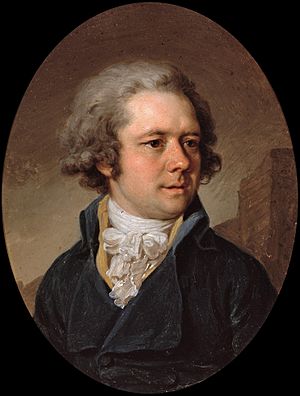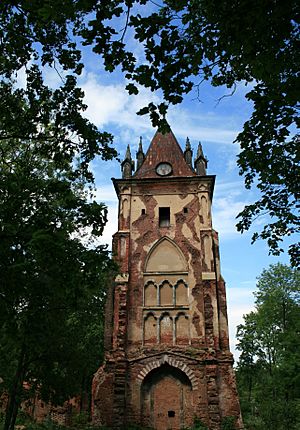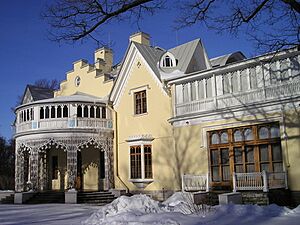Adam Menelaws facts for kids
Quick facts for kids
Adam Menelaws
|
|
|---|---|

Portrait by Vladimir Borovikovsky
|
|
| Born | 1748 to 1756 presumably Edinburgh
|
| Died | 31 August 1831 |
| Nationality | Scottish |
| Occupation | Architect |
| Projects | Alexandria Park, Petergof |
Adam Menelaws (born between 1748 and 1756 in Edinburgh, Scotland – died August 31, 1831, in Saint Petersburg, Russia) was a talented architect and landscape designer. He was Scottish but spent most of his career in the Russian Empire from 1784 until his death. Menelaws became famous in the early 1800s for designing homes and parks for important families like the Razumovskys and Stroganovs. Later, he worked for Emperor Alexander I and specialized in a style called Gothic Revival architecture.
From 1825 until 1831, Menelaws was the main architect for Emperor Nicholas I. Even though he was in his seventies, he became one of the most important architects in the entire Russian Empire. Much of his early life is not well known, but his amazing work in Russia speaks for itself.
Life and Early Work
Adam Menelaws was from Scotland. This was confirmed by an English traveler who met him in Russia. We don't know much about his childhood or education before he came to Russia in 1784. Historians believe he might have been from a family of builders in Scotland. Records show he was born either around 1748 or 1756.
In the early 1780s, a Scottish architect named Charles Cameron was working for Empress Catherine II in Russia. He placed an advertisement in a Scottish newspaper looking for skilled construction workers. Adam Menelaws was one of 73 craftsmen who agreed to move to Russia. He was considered one of the best stonemasons, especially good at building vaults (curved ceilings).
Menelaws signed a three-year contract to help build the Cold Baths near Saint Petersburg. He also agreed to teach Russian craftsmen. After about a year, he left Cameron's service and began working for Nikolay Lvov.
Lvov was a composer, poet, and architect who liked the Palladian style. Some historians think Lvov helped Menelaws a lot, while others believe he slowed down Menelaws's architectural career at first. For a while, Lvov had Menelaws search for coal in Russia. In 1786, Menelaws found good quality coal near Borovichi. However, it's likely that Lvov also used Menelaws's architectural skills for his own building projects. Menelaws was involved in Lvov's construction work from 1785 to 1794. Another Scottish builder, Walter Irving, worked with Lvov on a country estate called the Sun Temple. This building had a circular arcade that looked like the ancient stone circles in Britain. This circular design, or rotunda, later became a common feature in Menelaws's own buildings.
Menelaws married Elizabeth Cave in 1792. Many people from the English and Scottish communities in Russia attended the wedding. After 1795, Menelaws slowly started to work less for Lvov, though they remained friends until Lvov's death in 1803. Menelaws stayed a government employee in Russia until 1806. It was after Lvov's death that Menelaws's talent truly shone, especially when he began working for the Razumovsky family.
Designing Grand Estates
In the early 1800s, Adam Menelaws designed many beautiful English gardens for the Razumovsky family. One of the most famous was in Gorenki (now part of Balashikha). This garden was so well-known for its landscaping and private botanical garden that it was even mentioned in a famous book about gardening.

Menelaws also designed the Razumovsky Palace in Basmanny District of Moscow between 1801 and 1802. Sadly, this palace was destroyed in the Great Fire of 1812 and later rebuilt by another architect. Another large park, called Maryino, was created for the Stroganov family near Saint Petersburg in 1813. Unfortunately, most of these large park designs have disappeared over time. Menelaws often included a "Gothic ruin" in his park designs. This was a fake old building that looked like a ruin, used to add a romantic and historical feel to the landscape.
Menelaws also helped with the Maryino school, which taught peasants how to build with cob (a natural building material made from earth, straw, and water). This building method was introduced to Russia by Lvov, but Menelaws's Scottish background might have also played a role.
Work for the Emperors
In the 1810s, Emperor Alexander I asked Menelaws to redesign Alexander's Park in Tsarskoye Selo. Menelaws's new plan made the park look completely new, but he cleverly kept the original layout from the previous century. It was said that he combined the styles of two famous landscape designers, Kent and Le Nôtre.
Menelaws designed and built 12 structures in this park. These included the Egyptian Gates and three special park buildings:
- The large Arsenal (built 1819–1834), which replaced an older building.
- The White Tower (built 1821–1827), which was a house for the young Grand Dukes (princes).
- The Chapel (built 1825–1828), which was a decorative building (a "folly") that also provided living space for the palace chaplain.
These buildings used a mix of different European styles, known as romanticism. This style was popular after the Congress of Vienna, which reshaped Europe. It also showed Emperor Alexander's interest in spiritual and mysterious ideas. Alexander's Park was later used by Nicholas I, who also liked a mix of styles and medieval designs.
Nicholas I became Menelaws's biggest supporter, giving him important projects even when Menelaws was quite old. His most significant project, Alexandria Park, began when the architect was around 70 years old.
Before he died in 1824, Emperor Alexander I gave a large piece of land near Petergof to Nicholas I. This new Alexandria Park became Menelaws's last and best-preserved project. Work started with shaping the land and digging two large artificial ponds. After Alexander's death, Nicholas asked Menelaws to build his summer home, an unusual building called The Cottage. From the outside, it looked more English than Gothic, but the inside, designed by Menelaws, had stronger Gothic influences.
The park was designed in the English style, with winding paths around ponds. Its main feature was a Gothic Chapel, which was the private church for the royal family. The park also had other interesting features:
- An animal sanctuary for old horses from the palace.
- A farm.
- A menagerie with special buildings for llamas and elephants. Elephants lived in Alexandria Park until 1911 and were allowed to roam freely in the summer!
Adam Menelaws died in Saint Petersburg in 1831 during a cholera outbreak.


